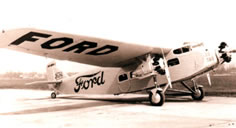After World War I, Henry Ford, who had put America on wheels, now wanted to put America in the air. In 1925, he built the first of 196 Ford Tri-Motor airplanes, the first airplanes used by America's first commercial airlines.

Seeing the Potential of Aviation
As a result of Edsel Ford’s involvement with the Stout Metal Airplane Company—he was an investor and a director—he and Henry offered Stout land for the airfield. The airfield opened in 1925.
Edsel then convinced his father to build the world's first purpose-built airplane factory on land adjacent to the airport. In the factory, the 1926 Ford "Tri-Motor" plane, a breakthrough in aviation reliability and safety, was built.
The Tin Goose
The Tri-Motor is the story of aviation's coming of age. Nicknamed "the Tin Goose" and "the Model T of the Air," the Tri-Motor was the first all-metal, multi-engine transport in the United States. It was so named because of its three 1,260 horsepower Pratt & Whitney engines. The Ford Tri-Motor planes were standard equipment on all commercial airlines until the flight of the Boeing 247 in 1933.
Ford's Tin Goose saw service in every quarter of the globe in the 1920s and 1930s; it carried freight in South America, smoke jumpers in Montana, and survey parties in Saudi Arabia. The Tri-Motor was the first to fly over the South Pole and the first to be used for transcontinental passenger service.
Ford Airlines Formed
Shortly after the success of the Tri-Motor, Henry discussed the future of aviation with William Stout of the Stout Metal Airplane Company. Henry thought that aviation could grow quickly and solidly with sufficient investment in the venture. It was agreed that Henry and Edsel would buy the issued stock of the company, keep William Stout on as an adviser, and form a brand-new company, Ford Airlines.
With one plane, Ford Airlines took off in 1925, with the intent of providing safe and reliable commercial aviation services. The new airline flew Ford mail and automotive parts on a scheduled basis between Dearborn and Chicago.
By the end of the second year, Ford Airlines had flown more than a half million miles and delivered more than three million pounds of freight. In January 1926, Ford Airlines began carrying mail for the U.S. government, making history with the first domestic airmail flight.
A Burgeoning Industry
Within a year, more than 20 airlines had sprung up, and air transport spread across the country. Ford Motor Company sold its Tri-Motor airplanes to commercial airlines, which used them as their commercial airplanes well into the 1930s.


